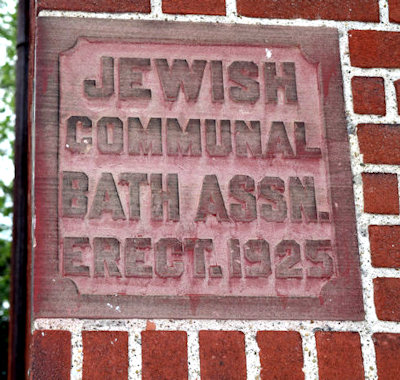|
|
|
|
|
Glenville’s Morison Avenue Russian Turkish Bath House and Mikvah |
||
|
Introduction At a time in its early history when population density exceeded bathing facilities, the City of Cleveland from 1904-1954 operated free year-round public bath houses. With a huge immigration influx in the 1890s, neighborhoods were densely populated and people didn’t have plumbing or running water. Residents who did have access to tubs reportedly used them for coal bins or storage, because they lacked money for the extra coal needed to heat bath water. Public showers were first made available to patrons of the Hiram House settlement. City officials and other concerned citizens advocated for placing public baths throughout the city. Mayor Tom Johnson, who served from 1901 to 1909, saw crowded tenement housing not only as a public health issue, but as a moral obligation to help the poor. One councilman, Frederic C. Howe was appalled to find that a district with a population numbering 4,500 had only eight buildings with any bathing facilities. In 1904, the first city-operated bath house opened on Orange Avenue, near the edge of the industrial valley, attracting more than 113,000 people during its first year. From the very first day of its opening, attendance was described as “highly gratifying.” People of all nationalities availed themselves of its services. This three-story facility contained private and open bath and shower rooms, a gymnasium, and laundry. Clubs and sports classes met there as well. Cost of a bath or shower was $.02, and included soap and a towel. Seven other similar facilities soon followed, including Broadway (1906) and Clark Avenue (1908). By 1908, there were about a half dozen bath houses in the city, some of them with gymnasiums and indoor pools. By 1929, only two of the facilities were used exclusively for bathing. |
|
“Shvitz”, Sleeping Rooms, Meals and Mikvah In 1925, The Morison Avenue Russian-Turkish Bath House (also known as the Jewish Communal Bath Building and mikvah) opened. Designed by Meyer Altshuld, an active Cleveland architect from 1914 to 1951, the Morison Avenue Bath House was located at 10606 Morison Avenue in the Glenville neighborhood. As reported in the May 22, 1925 issue of The Jewish Independent, the building’s dedication was planned for Sunday afternoon, May 24. The building was the first and only Jewish communal bath built by an Orthodox Jewish community in the United States. A feature of the opening ceremonies was the consecration of the individual ritual baths, following the initial consecrating ceremonies.
Scheduled speakers at the opening were: Rabbi H. F. Epstein of the
Chebas Jerusalem Congregation; Dr. Philip Rosenberg, newly-elected
rabbi of the Knesseth Israel Congregation; Rabbi Pelkowitz of
Canton, OH; Rabbi Herbert S. Goldstein of the Institutional
Synagogue of New York; and Dr. Leo Jung of the Jewish Center, NY;
and Rabbi Porath, eminent rabbi of Jerusalem whose speech would be
in English. Dr. Leo Jung started the movement for the communal bath,
just before leaving Cleveland to take charge of the Jewish Center in
New York.
As announced in The Jewish Independent display advertisement on June
26, 1925, shown below, the Russian-Turkish Baths “are a pleasure for
young and old.” “Fine meals served in our modern dining room.” The
mikvah was open daily (except Shabbos) from 8 a.m. to 12 p.m.
Russian-Turkish baths for women were available on Wednesdays.
Architect - Meyer Altshuld Epilogue “There was always a mikveh in Cleveland,” according to Gerald Spero, first president of the Cleveland Mikveh Association, as reported in a Cleveland Jewish News feature article on March 22, 1991. The Morison Avenue Bath House preceded the community mikveh located on Lee Road in Cleveland Heights. Although a mikveh is used strictly for ritual purification, having it in the bath house was for practical reasons. The building, which already contained a ritual pool, was owned by Cleveland butcher Nathan Gordon. Gordon and his wife, Rose (nee Wasserman) managed the bath house for thirty years. “The bath house was profitable,” noted Spero, continuing, “Gordon kept the mikveh open out of the goodness of his heart.” Money for necessities and upkeep, as well as the eastward exodus of Cleveland’s Jewish community resulted in the building of the mikveh on Lee Road. That building was completed in 1953. Due to its age and disrepair, it closed in 1997. By mid-century, as Cleveland moved into the modern era, and more workers lived with indoor plumbing, most of the bathhouses were razed or converted into other uses. The Morison Avenue Communal Baths and Mikvah was acquired by the Progressive Baptist Association in 1954. City of Cleveland Zoning and Planning records indicated a sign in the front of the building reading Progressive Memorial Home. Today, the building is now the home of the Morison Avenue Missionary Baptist Church. In spite of whatever exterior changes or adaptations may have been made to the original structure and its design, for the congregation’s contemporary Christian worship, evidence of the building as a local Jewish sacred landmark of worship is clearly visible on the front face. Although there is no appearance of any Star of David detail or other featured Jewish symbols, two cornerstones within the front’s right and left brick walls – one in Hebrew and the other in English – identify the building as “The Jewish Communal Bath Assn. Erect. 1925.” |
|
Bath House 1950 |
Bath House 2020 |
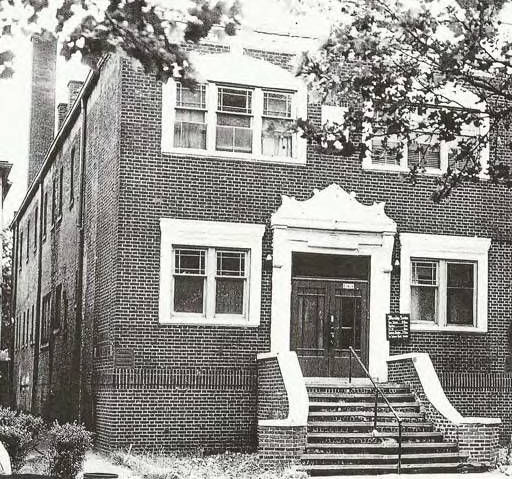 |
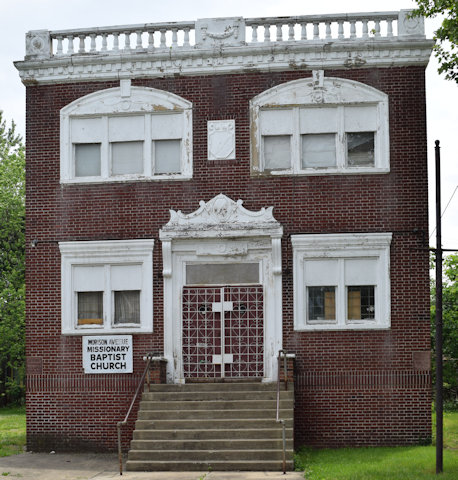 |
|
CORNERSTONES Hebrew stone reads "Immersion house/of the city of Cleveland/built in 5685" Images: Gail Greenberg |
|
|
|
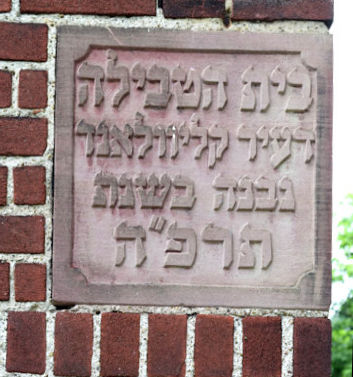 |
|
The Morison Avenue Bath House opens - June 26, 1925 |
|
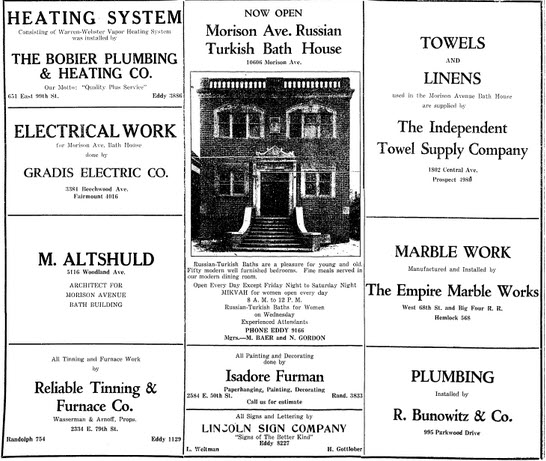 |
The Jewish Independent of June 26, 1925 announced the opening of the bath house.
Left: |
 |
|
|
A Memory of the Morison Avenue Shvitz Nate Arnold, local Jewish historian and “Old Jewish Cleveland” tour guide, shared highlights of going to the Morison Avenue shvitz as a boy of ten or eleven, with his father Irving. Nate also recalled Hersch (Harry) and Leah Sogolovitz, his great-great grandparents, who were from Lithuania. Hersch was reported to have been the manager of the Orange Avenue Bath House.
|
|
Three Buildings by Meyer Altshuld |
||
|
Knesseth Israel
Synagogue |
Morison Avenue Bath
House |
N’vai Zedek Synagogue |
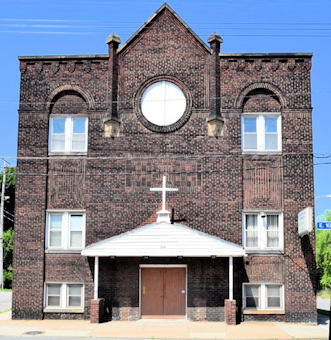 |
 |
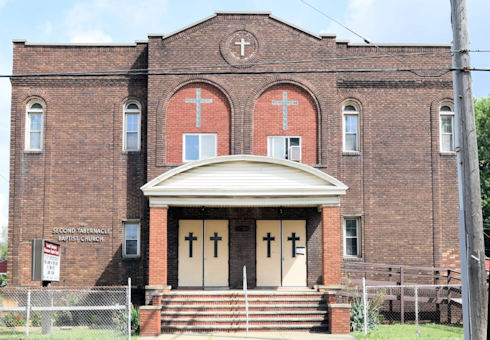 |
|
Images: Gail Greenberg |
||
|
References Advertisement, “Morison Ave. Russian Turkish Bath House” — The Jewish Independent, June 26, 1925. Arnold, Nathan. Personal Communication. March 26 and March 28, 2020. "Cornerstone of Jewish Community Bath Building to Be Laid Sunday" — The Jewish Independent, November 21, 1924. “Free Bath House” — The Jewish Review and Observer, April 13, 1906. "Jewish Communal Bath Building to be Dedicated" —The Jewish Independent, May 22, 1925. "Morison Avenue Bath House Open" — The Jewish Independent, July 3, 1925. Oster, Marcy. “The Cleveland Community Mikveh: rich history of the local ritual pool.” Cleveland Jewish News. March 22, 1991.
Cleveland City Council.
“The
Bygone Days of Bath Houses.” November 17,
2015.
Cleveland City Planning Commission — Cleveland Landmarks Commission Architects Database “Meyer Altshuld.” Cleveland Restoration Society. “The Jewish/African-American Connection.” Encyclopedia of Cleveland History. “Bath Houses.”
Learn More About the History of Cleveland’s
Bath Houses
and Jewish Community Mikvahs Chabad of Cleveland: Men’s Mikvah Women’s Mikvah Our page on “Going to the Schvitz” by Irv Seidman
Opens
New Kinsman Road Bath House” – The
Jewish Independent, November 25, 1927
|
|
ABOUT THE AUTHOR Gail Greenberg, MSEd. is an educator and library media specialist whose teaching experience includes public and private Jewish day and community schools, adult education, and professional development seminars. Currently, she is an adjunct faculty member at Cleveland State University in the Office of Field Services, supervising pre-service teachers. She is also a volunteer docent at The Maltz Museum of Jewish Heritage. She has published on Cleveland Historical. For her earlier contribution on this website see Building The Temple in University Circle |
